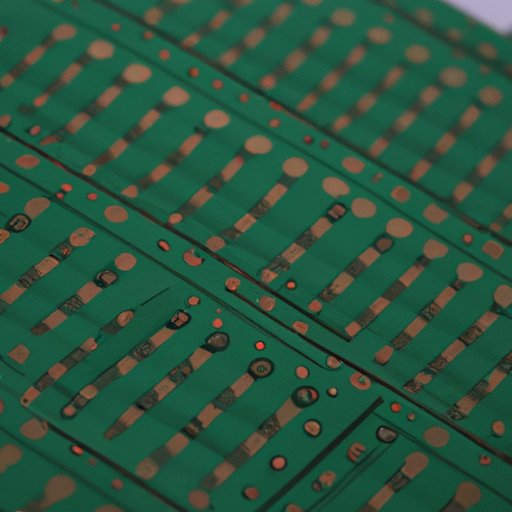Introduction
When we think of electronic devices, we usually picture sleek, compact gadgets that can fit in the palm of our hand. But have you ever wondered what makes these devices function and how their components communicate with each other? The answer lies in printed circuit boards, or PCBs. PCBs are essential components that serve as the backbone of electronic devices, connecting various elements and circuits to allow them to operate efficiently. In this article, we’ll provide an overview of PCBs, their manufacturing process and design, the different types of materials used for them, and some tips for troubleshooting common issues.
PCBs 101: The Basics You Need to Know
At their core, PCBs are layered structures that contain conductive pathways that connect various electronic components such as resistors, capacitors, and transistors. In other words, PCBs function like electronic highways that allow charges to flow through them, and they assist in organizing and compacting the components, increasing device functionality. PCBs have a ground plane layer, a power plane layer, and signal layers that connect various components. They are usually made of copper and fiberglass as the core material.
PCBs are used in a wide variety of devices, ranging from small gadgets like smartphones and watches to larger industrial equipment like medical devices, cars, airplanes, and even spacecraft. As such, there are a multitude of PCB sizes, shapes, and designs.
An Overview of PCB Manufacturing and Design
PCB manufacturing and design are incredibly intricate processes that require specialized knowledge, expertise, and tools. The process primarily involves designing the PCB layout using a computer program or PCB design software, then etching the layout onto a thin layer of copper, adding solder mask and silk screen layers, drilling holes into the board, and finally, placing and soldering the electronic components on the board. Different fabricators with specialized equipment and material knowledge are used to manufacture PCBs according to the design specification. An essential point to note is that fabricators need to follow specific industry standards and guidelines such as RoHS Compliance mandated by various organizations, including environmental agencies to ensure the longevity of the device and protect the environment.
When choosing the right PCB design software, beginners should consider software that has standardized libraries and DRC guidelines to optimize the design process and ensure no errors occur. Common challenges that arise during the PCB design process include power dissipation, electromagnetic and radio frequency interference, noise reduction, signal integrity, and thermal management.
The Evolution of PCBs: How They’ve Changed Over Time
The history of PCBs dates back to the early 1900s and has led to more complex and functional designs over the years. As technology has evolved, designers have had to incorporate different components, including microprocessors and wireless communication modules in their designs, leading to the evolution of flexible and modular PCBs. PCBs have also helped advance technologies such as self-driving cars and medical devices. For instance, boards are used in pacemakers and defibrillators for their low power consumption and shock resistance properties.
The advancements in wireless communication techniques, such as Bluetooth modules, NFC, and WiFi, have also allowed PCBs in devices to be able to communicate wirelessly, allowing them to be more powerful and interact with a broader range of devices.
PCB Material Guide: Which Type Is Best Suited for Your Project?
PCBs can be made from a wide range of materials, each with its advantages and disadvantages. Some of the most common materials include FR-4, ceramic, and metal-core PCBs. Fr-4 is the most common material used in the manufacturing of PCBs. It is inexpensive, easy to fabricate, and readily available, making it a popular choice for many applications. Ceramic PCBs are known for their excellent thermal conductivity, which makes them an ideal choice for devices that generate a lot of heat. Metal-core PCBs are best suited for high-power applications such as LED lighting and automotive headlights.
When selecting a PCB material, some factors to consider include cost, performance, availability, and thermal management. It’s essential to select a material that can handle the heat generated by the device’s components without damaging them, the material should also allow for more significant current capacity for high power applications.
Troubleshooting PCBs: Tips and Tricks for Effective Debugging
Like any other electronic component, PCBs can have issues that affect their performance. Some of the most common issues include short circuits, open circuits, and component failures. To troubleshoot PCBs, specialized circuit board test equipment such as multimeters is often used to debug issues.
Other strategies that can be used include double-checking the voltage and current of each component, re-flowing components to correct any solder issues, and checking for signal integrity issues. In addition, understanding ohm’s law or Kirchhoff’s law on circuit analysis is crucial in helping you to isolate and identify issues.
Conclusion
PCBs are undoubtedly one of the most important components in modern-day electronics. From their basic working principles to the intricacies of choosing the right materials and manufacturing them, understanding their role is critical in designing and troubleshooting electronic devices. While the manufacturing process is taken care of by specialized companies, it is essential to have a good understanding of how PCBs work to communicate your ideas effectively to fabricators. Hopefully, this article has given you some basic insights into the world of PCBs and provided some helpful tips for troubleshooting issues.
We encourage readers to learn more about PCBs by attending trade shows, taking online courses, or experimenting with different PCB designs. With the right knowledge and expertise, the world of PCBs is endless, and their applications are vast.
